
Intrinsically safe laptops (also called explosion proof laptops) are not your average laptop. They are even more rigorously tested than most rugged laptops as they are expected to endure more than just rough bumps and drops. Explosion proof laptops are meant to survive hazardous environments under extreme conditions without risking potential explosions caused by the laptop’s electrical energy.
To get a better of idea of the purpose of an intrinsically safe laptop, here are a few tests used to determine laptop ratings.
- Intrinsically safe laptops first need to be tested to see if they are intrinsically safe. These tests are run to ensure the equipment does not generate enough electrical current or signal to set off explosions. Different classes and groups are used to indicate what type of gas or compound the laptop can be safely operated. For example, Class I, Div. 2 is safe for operation around flammable substances in abnormal conditions, and Group D means the computer is safe for use near benzene, butane, and propane.
- Many explosion proof laptops need to meet certain military specifications (specifically the MIL-STD) to be considered acceptable. To be MIL-STD certified, these computers must withstand damage against extreme temperatures, rain, different types of fog (including salt fog), and sand (in case of desert use). They are also tested against less obvious environmental conditions, such as explosions, shocks, dropping, and fungus.
- The International Protection Rating (IP Code) lets the consumer know how the intrinsically safe laptop performs against tests in water and against objects (including how it is affected by dust). Each type of test has different levels to let potential buyer know what kind of conditions the laptop can survive (the higher the IP, the more the laptop can withstand).
Now that you have an idea what types of specifications intrinsically safe laptops must meet, it is easier to understand their real-world uses. People who work in hazardous environments do not need yet another risk in the form of their laptop. Here are a few real scenarios where having and explosion proof laptop significantly reduces the risks to the workers.
- Firefighters can use intrinsically safe laptops and other devices to assist in fighting more difficult fires, such as in large buildings, airports, or fires where gas leaks are a major concern. Firefighters learn to use these devices during their regular training. The devices help to identify where problem areas are. They can even help track where the firefighters are.
- With the high volume of flammable vapors around oil rigs, those stationed on them use intrinsically safe laptops to help minimize the risk of causing an explosion. Workers can use the laptops as they check different aspects of the rig, entering information as they go so that data is updated in real time.
- In mining, workers can take pictures of potential problems without having to worry about igniting highly flammable areas where natural gas is extracted. They can write notes in the laptops as they check piping or storage areas.
- Cleanup workers following an oil spill or other toxic event are able to use intrinsically safe laptops while still in full gear (including their gloves). This allows information to be relayed quickly to get a better idea of how much work remains without having to wait for workers to be decontaminated.
- Monitoring the air in a chemical factory to ensure that it is not hazardous can be done with an Atex laptop. This ensures that noxious chemicals resulting from a leak are not accidentally ignited by a regular computer.
F.O.K. Marketing ltd works with ecom intruments uk in helping people with the understanding of products such as intrinsically safe laptops and other explosion proof equipment.










Comments